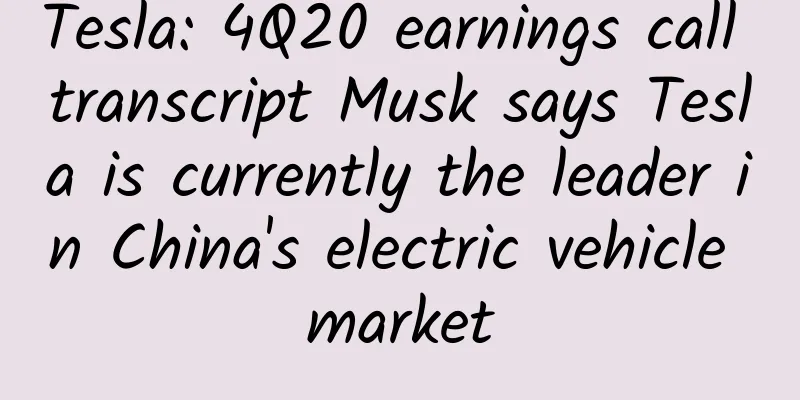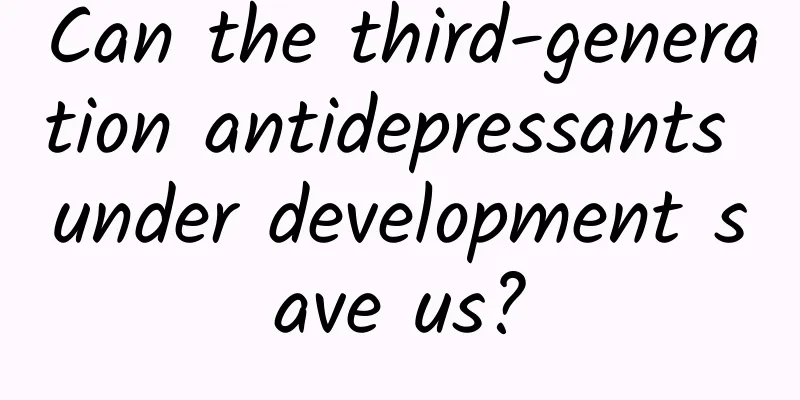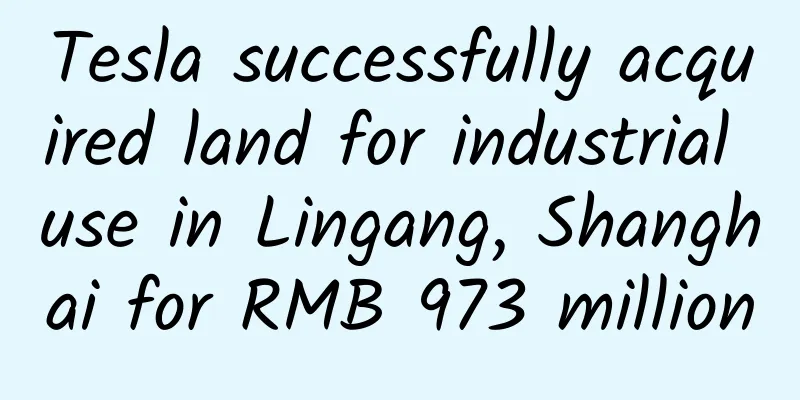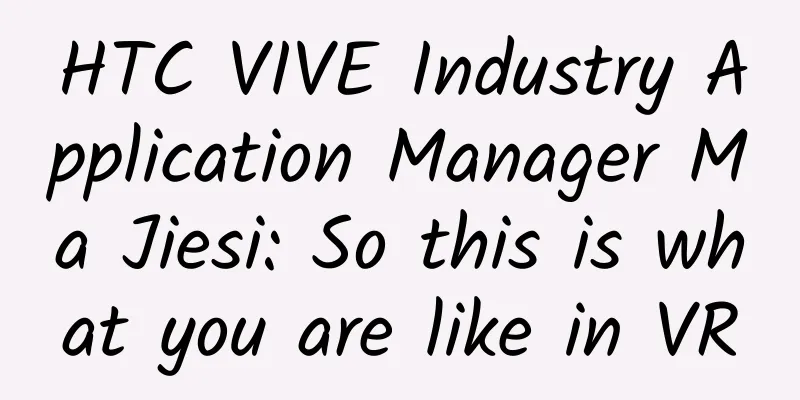Tesla: 4Q20 earnings call transcript Musk says Tesla is currently the leader in China's electric vehicle market

|
January 28, 2021 Tesla (NASDAQ: TSLA) released its fourth-quarter financial report on Thursday as of December 31, 2020. The financial report shows that Tesla's total revenue in the fourth quarter was US$10.744 billion, up 46% year-on-year; the net profit attributable to Tesla was US$2.7 billion, up 157% year-on-year. After the financial report was released, Tesla CEO Elon Musk, Chief Financial Officer Zach Kirkhorn and Investor Relations Director Martin Viecha attended the financial report conference call and answered questions from analysts on the spot. [ Tesla's fourth-quarter revenue exceeded expectations, but its profit fell short of expectations, and its stock price fell more than 4% after the market closed ] The following is the transcript of the earnings conference call: Analyst: What's holding Tesla back from becoming a solar industry leader? Elon Musk: Solar energy actually grew significantly last year, and it performed best in the fourth quarter of 2018. We think Tesla will become an industry leader in solar energy, and we can go even further. We still need to devote the entire company's energy to the production of Model 3 in the next few years. In fact, we have put all the manpower in solar energy into the automotive sector. However, we are also shifting our attention to solar energy because it is growing very fast. It won't take too long for Tesla to take the lead in solar energy. Zach Kirkhorn: Another important part of our strategy for the solar business is to strive to lead the industry in cost structure so that we can have pricing power. This is what we have achieved in the past year. As Elon Musk mentioned, this is very important for leadership in pricing, so that we can lead the industry. Elon Musk: The important thing is that we will integrate Tesla's Powerwall home battery and solar energy by the end of this year. We have a great strategy, as Zack mentioned, we are focused on saving the relevant time costs and resources, and will eventually make progress. Analyst: Can car owners transfer the FSD fully autonomous driving system to their new car? Will this help cultivate user loyalty and promote sales? Elon Musk: We are not considering this issue at the moment. We are indeed considering raising the price of cars equipped with FSD. Consumers and the stock market have underestimated how good FSD will be. At this moment, we are not considering the possibility of transferring FSD. We will launch a membership system in the next month or two. Analyst: How is the progress on dry battery electrodes? At Batter Day, Elon mentioned that the production volume is still quite low. Drew Baglino, Senior Vice President of Engineering: That's right. Our internal manufacturing system mentioned on Battery Day that we are using new production processes and production equipment. We predict that there will be some technical challenges and unknowns in increasing production. However, our team has solved all the problems that have arisen and will further increase production capacity. At the same time, our engineering team is also further improving the design of the "4680 battery", and our further mastery of relevant knowledge also makes us more confident in achieving cost targets. In terms of production capacity, we have equipment that can produce a total of 10 megawatt-hours of products, production-related personnel have basically been recruited, the material supply chain is basically in place, and the team is ready to finally reach full production capacity this year. We are very confident in the design, production process and equipment of the "4680 battery", and we will have the opportunity to achieve the goal of 100 megawatt-hours of products in 2022. Analyst: Why are you confident that you can achieve Level 5 autonomous driving in 2021? Why is DOJO not a necessary condition to achieve this goal? Elon Musk: Our confidence is based on our understanding of the technology roadmap and the experience we have gained in the iterative process. It is not necessary for the car to fully achieve point-to-point autonomous driving in complex road conditions. This is not just about improving its performance and reliability to achieve 99.9999% safety. Instead, it has to perform twice or twice as well as humans. This business is progressing very quickly. We have obtained a lot of training data and the performance of the software has been greatly improved. We have also made labeling software, which is quite challenging. We are moving towards video labeling, and there will be further progress in data training for video labels in the medium term. We are doing a great job in upgrading all the traffic networks to video-based data. This is a hot topic, and video labeling software can make labeling more efficient. Auto labeling is something we are looking forward to. We have invested a lot of effort in improving the performance of labeling tools. And DOJO, the training supercomputer, is what we think is probably the best neural network training computer in the world. We may even offer DOJO as a service to people who need to train neural networks, but we don't want to monopolize this technology. It's very important for us to train on a large amount of video data to achieve performance that is one, two, or 20 times better than humans. Analyst: What is Tesla's current production capacity of "4680 batteries" in megawatt-hours? So, what will this number be in the middle and end of 2021? Elon Musk: In 2022, the production target of the "4680 battery" is 100 MWh. The production capacity will increase significantly, and our goal is to reach a production capacity of 200 MWh/year. Zach Cockhohn: According to the S-shaped production curve, production may lag behind slightly in the previous month, but may make great progress in the next month. We are trying our best to improve our production curve. Elon Musk: We don't see any inhibitors. Analyst: Tesla used to be renowned for its excellent customer service, but now users can't even call the customer service line, and customer service is pushed back to several weeks later. What measures has Tesla taken to improve the service experience? Jerome Guillen, President of Automotive Operations: We believe that the best service is no service. Therefore, we have devoted a lot of effort to improving the quality and reliability of our cars. In the past two years, the frequency of users contacting customer service has been reduced by one-third. Users do not need to contact customer service so frequently, which is our real ultimate goal. If customer service is really needed, we want to make it as easy as possible. The relevant measures we have taken include increasing mobile service, which accounts for 40% of all service volume in North America. We hope to increase this number to 50% this year. 50% of the customer service process takes less than two hours. We want to solve vehicle problems at an extremely fast speed so that users can get their vehicles back quickly. In terms of customer service appointments, we are still in the process of further improvement. We actually have 140 customer service centers in North America. Among them, 100 can provide appointment services within ten days. We will further ensure that all customer service centers can provide short-term appointment services. Zach Kirkhorn mentioned that we are accelerating the expansion of customer service centers. In North America, we opened 11 new customer service centers in December last year. In the first half of this year, we plan to open 46. In terms of customer service calls, we will focus on software. We want all communication to be done on the software, that is, Tesla's app, and avoid the use of customer service calls as much as possible. The app is much better than the phone, it can be used in the car, and you can directly make appointments for related services. There is a history of all the communication between users and the customer service team, you can send photos, you can process payments without entering credit card information, you can update related services, and more functions will be launched later. By then, everyone will be satisfied with the app. It also helps to directly locate the specific location of the technician responsible for your vehicle, calculate how long it will take him to get to your location, and understand the specific situation. We invest a lot of resources in the app. I think other companies should do the same. This is our future! Analyst: What key milestones need to be achieved in order for the FSD fully autonomous driving system to reach the fourth or fifth level of autonomous driving that can be used for commercial car sharing? Elon Musk: As I mentioned earlier, we need to upgrade all neural networks to video neural networks. To achieve this goal, we need to collect video materials, and it must be surround panoramic video. At the same time, we need to set up 8 cameras and shoot 8 videos at the same time. We also have to label the content in these videos, and then let this video neural network control the vehicle. We have to go from no video neural network, to single-lens single-frame neural network, to multiple lenses, plus time coordinates, and finally form a video neural network. In fact, we just have to do what we should do. Based on the FSD beta version we released, there will be great progress, and we will let more people join in. In my opinion, the future route is very clear, and it will be safer than human driving. Analyst: Does Tesla plan or consider licensing related software applications to other automakers, especially the FSD fully autonomous driving system and the automated energy trading platform AutoBidder? Elon Musk: We are open to licensing our software to other automakers. We have had preliminary discussions about licensing Autopilot, and we are happy to do so. However, we have to do more work to prove that Tesla Autopilot can drive itself, which should be accomplished this year. We are definitely happy to share it with other car companies, and we don't want to be the only one. The same is true for the automated energy trading platform AutoBidder. Our goal is not to build a closed platform. We will allow other companies to use our Supercharger network, AutoBidder, etc. Analyst: What are the main differences between China and other parts of the world in terms of products, user preferences and FSD fully autonomous driving system-related strategies? What different measures need to be taken to gain market share in China's electric vehicle market? Elon Musk: We are currently the leader in the Chinese electric vehicle market, and we must have done something right. But I have to admit that only 1% to 2% of users in China have chosen the FSD fully autonomous driving system, which is much lower than in other parts of the world. We will make the FSD fully autonomous driving system in China better, and then the sales will be higher accordingly. Chinese users are more cautious and pay more attention to details. I am very confident that as long as the FSD fully autonomous driving system works well in China, sales will naturally go up, and I hope that sales will increase later this year. Analyst: Can we say that the company's long-term revenue capacity is closely related to the profit per unit battery load? The 3 trillion watt-hour target mentioned on Battery Day means that if your goal is to sell 20 million vehicles, and based on the corresponding battery capacity, half of the battery production capacity will exist in the form of inventory? Elon Musk: That's right. The most fundamental limiting factor for electric vehicles is the capacity of the battery. Our development cannot outpace the production capacity of the battery factory. At present, Tesla has greatly improved the efficiency of the vehicle, which means that even with the standard range battery pack, the actual mileage has also increased to a certain extent. Model 3 can reach more than 200 miles. In addition, through the improvement of other details, this value will reach 300, or about 500 kilometers, when equipped with a standard mileage battery pack. But fundamentally, growth depends on battery production. Of course, many companies want to sell their batteries. But why does Tesla want to produce its own batteries? We want to promote growth. We are not trying to suppress our battery suppliers. In fact, Tesla wants to purchase more batteries from battery suppliers, and our suppliers know this, whether it is CATL (Contemporary Amperex Technology Co., Ltd.), Panasonic, or LG, we very much want them to increase their production capacity and we will purchase as much as they produce. Obviously, there are also price constraints because we still want to make the vehicle as affordable as possible. The point I want to make clear is that we are not producing our own batteries because we want to get rid of suppliers. We want to fill the capacity gap that suppliers cannot or do not want to fill. Since battery production drives vehicle sales, increased vehicle sales can further double the revenue of the autonomous driving business. This is Tesla's long-term goal, and it will also bring value to the company. Analyst: Regarding the "4680 battery", how are you progressing in the development of the Cybertruck pickup truck? Do you plan to deliver the Cybertruck pickup truck in 2021? Elon Musk: We have basically completed the engineering design of the Cybertruck pickup truck. We are no longer in the design stage, the design part is done. We will soon order the equipment for the production of the Cybertruck pickup truck. We will use the larger Tesla self-developed equipment to produce the rear body of the Cybertruck pickup truck, because obviously, it is larger, the truck bed is longer, and the load capacity will be large. So we're going to use an 8,000-ton die casting machine for the rear body, and for Model Y we're using a 6,000-ton die casting machine. The 6,000-ton die casting machine is the largest die casting equipment in the world. The 8,000-ton one is much larger than that. This model will be unparalleled. If we're lucky, we'll be able to deliver some products by the end of this year, but I expect to be in mass production in 2022. Analyst: Can you talk about the regulatory environment for FSD? How is it going? Obviously, it seems difficult to say, and you are indeed hindering them. We would like to hear how you communicate with them? What impact will this have on the promotion of FSD in this year and next year? Zach Kirkhorn: What we have observed in the United States is that there are many changes in this field. But in general, they are not restricting it in terms of rules. Instead, we need to do a lot of work to show regulators the extremely high reliability of our products. Analyst: Another question is about the inflation in the raw material market. There is currently a lot of low interest rates for basic raw materials. What is your current supply chain like? How will you avoid issues related to raw material costs? Jerome Guillen: Regarding the supply chain, the priority right now is to deal with the disruptions in transportation due to the COVID-19 pandemic, especially between Asia and North America. We are also very focused on pricing and we are paying close attention to the prices of all components. We are signing a series of long-term agreements with preferred suppliers to ensure not only that the volume is sufficient to maintain growth, with a compound annual growth rate of 50%, but also that there is a good price based on a reasonable risk sharing. Analyst: Two questions, one for 2021 and one for capital. What will the situation be like in terms of regulatory credit sales? In addition, you raised a lot of capital in 2020. Where will you use it besides paying the relevant fees of the maturing loans? Can you talk more about where you will use the high liquidity and where you will not use it? I mean, to what extent can the high liquidity enable you to accelerate the progress of building capabilities or accelerate vertical integration to accelerate the progress of comprehensive self-driving functions? Zach Kirkhorn: It's not always hard to predict when it comes to regulatory and credit sales. The sales of regulatory credits in 2020 ended up being higher than we expected, so that's a hard area to predict. In the long term, regulatory credit sales will not be a significant part of our business, and we don't plan around it. It may be strong for several quarters, or it may not be. Most of the fourth quarter regulatory credit sales were not planned before the quarter. These are also scattered businesses. I would like to give you more information on this, but it is quite difficult to predict. In terms of capital, we are considering several aspects. As I mentioned earlier, debt reduction is a major concern for us. Early debt conversion is not an option for us. In the fourth quarter of last year, we converted about $2 billion of debt. Currently, we expect to reduce debt by $1.4 billion in the first quarter of this year due to early debt conversions or convertible bonds. Debt may continue to rise, so debt reduction is important. This will also help reduce interest expenses. We're also using that money to invest in future capacity. What we can do now, which we didn't have the opportunity to do in the past, is we can build capacity, especially in Austin and Berlin. Rather than slowly ramping up capacity, we think about where we want it to be and invest accordingly. So that's an important component in terms of capital efficiency, and we never had the opportunity to do that in the past. It's great to have enough liquidity to focus on that. The expansion of services is critical to the company's future strategy. As mentioned in the fourth quarter financial report, the scale of service centers and mobile services increased significantly from the third quarter to the fourth quarter, and also increased a lot compared to the first half of this year. We are now able to invest in this area and also invest in the super charging network to prepare for future demand, which will cost us more in the short term, but it is the right thing for our users and our company itself. Analyst: You mentioned that you want to increase the number of batteries you purchase from suppliers. Does this require them to also have the ability to manufacture "4680 batteries"? Elon Musk: No, it is not necessary. Although we are communicating with them about the production of "4680 batteries", it is not necessary. For example, the new Model S uses "18650 batteries". "4680 batteries" are just slightly more advanced, and we will continue to use existing batteries in the next few years. However, we will gradually replace the old battery models and switch to relatively consistent battery models. But this does not mean that we have such requirements for suppliers. The better solution is that we have the ability to deal with multiple types of batteries ourselves, rather than requiring our suppliers to provide a specific model. Of course, in the long run, it is definitely more beneficial to use a certain type of battery. Analyst: Regarding increasing production, one thing is investment, and the other is qualified human resources. Have you encountered any obstacles that limit growth in this regard? Elon Musk: This will hinder the focus on a certain area or limit the growth rate. This will not affect the final scale, but it will affect the speed at which we can recruit more talents and train them in the right areas. If you have a factory with 20,000 employees, you can't hire 20,000 employees immediately. They are usually doing other things. They have to pull out of whatever they are doing or move from somewhere else. So it takes some time. We do think that we can maintain growth rates of over 50% per year for many years to come. Analyst: Elon, in 2018, you tweeted about electric trucks and how interesting it would be to work with Daimler and Sprinter. We haven't heard anything since then. But at the same time, we see a lot of well-known startups very active in the electric truck and last-mile space. You said you have a lot of projects going on. Can you talk about the latest views on this market? Are you still interested in this area? Elon Musk: Tesla will definitely produce electric trucks. It should be noted that the most fundamental problem is the limitation of batteries. It is difficult for people without manufacturing experience to imagine how difficult it is to increase production. This is the most difficult thing in the world! Making prototypes is relatively easy. The main reason we haven't accelerated the development of new products is that, for example, Tesla's Semi electric truck doesn't have enough batteries. If you want to put the existing Semi prototype into production, it is easy to do. But we don't have enough batteries. When we produce the "4680 battery" ourselves, we will have enough batteries for the Semi electric truck. The Semi electric truck requires five times the amount of batteries required for a sedan, but it does not bring in five times as many sales. So it makes no sense for us to manufacture Semi now. Once we can solve the bottleneck of battery production, it will definitely make sense for us to produce Semi. Analyst: OK, thank you! Maybe I can dig up some of your past. About two years ago, at the Autonomous Driving Investor Day, you said you were working on the next generation of Tesla chips, which is about two years later. Any new progress? Elon Musk: Yes, to be clear, the software still can't fully use FSD on 1 computer. I personally believe that people can achieve safety level 5 full self-driving with just the first generation of full self-driving computers. For the second generation, we want it to be 2 times more powerful than the first generation, working with higher resolution cameras. This requires changing a lot of things at the same time. But we are not rushing to launch version 2 of the chip. We are making good progress. If we were to launch full self-driving right now, which is Tesla's FSD chip 2, we would be distracted because the chip would set us back quite a bit on the software level, which is the key to achieving full self-driving. So I'm not too worried about that. It's an improvement, but it's not the most critical variable. That has to change. Getting the software to work and getting all the neural networks to video is the key variable. Analyst: Thank you very much. My first question is about your independent manufacturing of batteries. In addition to increasing production capacity, you emphasized that the goal is to reduce prices or costs by 50% and increase product variety by 50% in a few years. So I want to know if you are working in these directions initially? What is the specific time to achieve these goals? Perhaps related to this, how do you view Tesla's model of gaining market access by keeping prices low? Elon Musk: We are very confident that we can achieve these goals in 3 years. 3 years, maybe 4 years, give ourselves some wiggle room. Zach Kirkhorn: Yeah. We integrated the progress that we made at Battery Day, and we're still on track. I think that's probably the best reference for our current cost trajectory. Elon Musk: Yes. We hope to do better than what we showed on Battery Day, but we are at least confident in the results we showed on Battery Day. Analyst: Let's try to sort out the details. If I remember correctly, 10 years ago, you talked about how you would step down as CEO and become chief designer when Tesla was able to produce mass-market cars. Elon Musk: Well, I hope to be the CEO of Tesla for a few more years, and I think I still have a lot of exciting things to do. I think it would be hard to leave. So I hope to continue to run this company for the next few years. Obviously, no one is always the CEO now, and people shouldn't stay in the CEO position. The workload of Tesla's CEO is unimaginable. I think I probably do more - I do more technical work than the average CEO. So it would be nice if I could have more free time instead of working 24/7, from the time I wake up in the morning to the time I go to bed at night, which is very intensive. But I think the mission is not over yet, and we still have a long way to go before we can really accelerate the arrival of sustainable energy. I mean, Tesla's goal, from the beginning, has been to accelerate the development of sustainable energy. But if you ask what percentage of cars on the road today are electric, it's still a very, very small percentage, about 1%, or less than 1% of the total number of cars in the world. So there's still a long way to go, only 1% of cars are electric. Solar has a long way to go, although we're excited to see very cost-competitive wind, solar and geothermal. And of course, we need a lot of stationary battery packs. I mean, basically, the three main directions of sustainable energy future are sustainable energy production, solar, wind, geothermal and hydroelectric and some others. I'm not against nuclear power. In fact, I think nuclear fission in a well-designed reactor, when it's not affected by bad weather, is actually a good thing. The second thing you need to do is storage of a fixed amount of electricity, because most renewable energy is intermittent. The wind doesn't blow all the time. The sun doesn't shine all the time. So you need a lot of batteries. It needs to be very durable and high cycle life. And then you need electric transportation. If you can do those three things, we have a very bright future in terms of energy and the environment. So there's still a long way to go. So I'm still very motivated to do this. I'd be happy to see an update on the timing of the Semi. First, since the range of a semi-truck is generally predictable, will Tesla's Semi be the first vehicle to achieve fully autonomous driving? Elon Musk: I think it's very likely. Yeah, I'm not sure who's going to be second, but yes, it's very likely, yes. Jerome Guillen, President of Vehicle Operations: The number of hardware components on the Semi truck is no different than on other Tesla vehicles. Elon Musk: Yes. Just like now, we modify the software parameters of Autopilot or autonomous driving in Model 3 and other cars. We will only need to notify the FSD brain to complete it. Analyst: So is there a need for retraining as part of this? Elon Musk: No, I think there will be different controls because there are some cornering designs that you can do on a normal car that you can't do on a truck, like if you want to parallel park on a city street. It needs to know its own limitations as a giant truck. Analyst: That makes sense. My follow-up question is, can you help us explain why battery electric technology will eliminate hydrogen cell fuel technology? Elon Musk: Yeah. I mean, I've had this question countless times, honestly, about regular vehicles, even in the early days of the sports car, even before the sports car came out. People said that at some point hydrogen was going to be a better way to store energy in cars than batteries. But that's not the case. Hydrogen is number one on the periodic table, and it's very low density. It's as low density as a liquid, like Styrofoam. It's just a liquid very close to absolute zero. So you have to keep it liquid, which is unrealistic. You want to make it a gas with a lower density and a high pressure, and you need a tank that's huge, and it has to be at a very high pressure. Basically. If someone were to say, the ultimate chemical energy storage mechanism to replace hydrogen, I would say propane or something like that, or methane - those would be much better than hydrogen. And then turning it into a fuel cell would just complicate the situation. It's just crazy. We are very confident that we can make a long-range truck with batteries. If you think hydrogen fuel can do it, then how much weight do you need to, let's say, use the watt-hours per kilogram of battery available to go 500 miles? How much does that affect the payload? Jerome Guillen, President of Vehicle Operations: I agree. We are also seeing more and more truck regionalization. I think it will be perfect, the Tesla truck is the perfect fit, and I look forward to seeing more people participating soon. Elon Musk: But basically, we don't think there's any problem with building a long-range truck with batteries. The problem is battery supply, only battery supply. |
<<: LeTV launches a super combination punch to impact traditional e-commerce festivals
>>: GSMA: Benefits of 5G deployment in Russia
Recommend
What are the indoor entertainment places in Qinhuangdao? Where is the best place to go sightseeing in Qinhuangdao?
There are the following interesting places in Qin...
Zero-based flat texture style commercial illustration tutorial
In modern society, commercial illustrations are a ...
Netflix CEO says it will launch ad-free paid video service in China
On April 17, according to foreign media reports, ...
Where is the most brilliant starry sky? China's large optical observatory is located on the Qinghai-Tibet Plateau
Looking up at the stars is the oldest human behav...
iOS 15 released two versions in a row! Here are the upgrade suggestions
In the early hours of yesterday morning, Apple up...
Is Suning crazy to spend 150,000 yuan on a refrigerator just to hear the noise during its 618 event?
The future world must be intelligent and convenie...
Is it possible for Netflix, which became famous due to "House of Cards", to enter China?
Chinese video websites like to call themselves th...
Ginkgo biloba is an endangered plant, even though it can be found everywhere.
Review expert: Liu Xiaolu, Senior Engineer, Urban...
Zhu Baiban's Douyin sales promotion course
Zhu Baiban's Douyin Advanced Course Resource ...
How can a startup brand carry out marketing promotion?
This article combines marketing promotion theory ...
The protagonist of "The World" died of stomach cancer. What habits are harmful to the stomach? What should we do to prevent stomach cancer?
The protagonist of the hit TV series "The Wo...
The World Health Organization announced that it will be completely eradicated by the end of 2023! All about its files and "crimes" are explained at once
Image from: freepik.com Recently, the World Healt...
When will the Shanghai epidemic end in 2022 and return to normal? Can May Day end and return to normal? Attached the latest news
Recently, the number of new local cases and asymp...
Coffee + alcohol = double the carcinogens? Here comes the September science rumor list →
1. If you use "traditional remedies" su...









